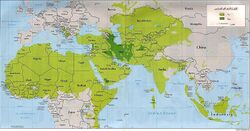Green Belt Theory
Topic: Unsolved
 From HandWiki - Reading time: 4 min
From HandWiki - Reading time: 4 min
The Green Belt Theory or hypothesis (Persian: نظریه کمربند سبز, romanized: nazariye kamarband sabz), is a kind of conspiracy theory [citation needed] found in Persian sources.[1][2][3] It explains the Western world's series of efforts in some countries to regenerate religion in their societies and make a strong preventive belt against the Soviet Union at the time. It supposedly starts with establishing religious schools in India[4] and continues with supporting religious governments in Pakistan in the 1940s. It resulted in the arming of religious groups in Afghanistan, in the 1980s.[5]
Background
From the nineteenth century, Lord Curzon brought with him a strategy of creating "a Moslem nexus of states" in the Middle East as a shield to ward off Russian expansion.[Fromkin 1] He proposed to take advantage of the situation by putting his British-sponsored Moslem nexus of states into place, When the Bolshevik Revolution brought about Russia's withdrawal from her forward positions. That nexus would have been a line across the Middle East from the Ottoman Empire through the Persian Empire to the khanates and emirates of Central Asia and Afghanistan in the nineteenth century.[Fromkin 2]
1979 Iranian Revolution
In relation to the 1979 Islamic revolution in Iran, the "Green Belt Hypothesis" is a geopolitical theory that was proposed during the Cold War era. It suggests that the United States, along with some Western powers, supported the creation of a "Green Belt" composed of Islamic fundamentalist states, in this case, Iran, in the regions surrounding the Soviet Union.[6][7]
The hypothesis posits that the intention behind this support was to weaken and destabilize the Soviet Union by promoting Islamist movements as a counterforce. The term "Green Belt" refers to the Islamic symbolism associated with the color green, which is often linked to Islam.
According to the theory, by encouraging the rise of Islamic fundamentalism[8] and supporting groups such as the Mujahideen in Afghanistan, the Western powers aimed to divert Soviet attention and resources away from their own territories. The idea was that by promoting Islamic fundamentalist movements, the Soviet Union would face internal challenges and unrest within its Muslim-populated regions, potentially leading to its eventual downfall. This has been subject to debate and criticism. Some argue that there is evidence to support the idea of Western support for such a revolution during the Cold War as it has mobilized, influenced, or facilitated more and more extremist movements across the world. While others dispute its significance or question the extent to which it was an intentional strategy.[9][10]
References
- ↑ نیشابوری, سرهنگ نصرالله توکلی; Tavakoli-Nishabouri, Nasrollah (21 March 2014). آخرین سقوط آریاها، خاطرات اولین رئیس ستاد ارتش پس از انقلاب: Memoirs of Nasrollah Tavakoli, The First Chief of Staff of the Iranian Army after the Islamic Revolution. Ibex Publishers. ISBN 9781588140982. https://books.google.com/books?id=gescDgAAQBAJ&pg=PT593. Retrieved 8 January 2018.
- ↑ میرزادگی, شکوه (15 May 2015). معجزهی تو. H&S Media. ISBN 9781780834924. https://books.google.com/books?id=1rhyCQAAQBAJ&q=%22%D9%83%D9%85%D8%B1%D8%A8%D9%86%D8%AF+%D8%B3%D8%A8%D8%B2+%D8%A8%D9%87+%D8%AF%D9%88%D8%B1+%D8%A7%D9%8A%D8%B1%D8%A7%D9%86%D9%89%22&pg=PT234.
- ↑ Nahavandī, Hushang; نهاوندی, هوشنگ (24 May 2018). خمینی در فرانسه: Khomeini dar France. Ketab.com. ISBN 9781595842770. https://books.google.com/books?id=rNtISWgFiWIC&q=%D8%A8%D8%B1%D9%82%D8%B1%D8%A7%D8%B1%DB%8C+%DB%8C%DA%A9+%DA%A9%D9%85%D8%B1%D8%A8%D9%86%D8%AF+%D8%B3%D8%A8%D8%B2+%D8%A8%D9%88%D8%AF&pg=PT94.
- ↑ Hardaker, Glenn; Sabki, Aishah Ahmad (14 September 2015). "Islamic pedagogy and embodiment: an anthropological study of a British Madrasah". International Journal of Qualitative Studies in Education 28 (8): 873–886. doi:10.1080/09518398.2014.917738.
- ↑ Hardaker, Glenn; Sabki, Aishah Ahmad (30 November 2014). "Islamic Pedagogy and Embodiment: An Anthropological Study of a British Madrasah.". International Journal of Qualitative Studies in Education 28 (8). https://eric.ed.gov/?id=EJ1073422. Retrieved 8 January 2018.
- ↑ نیشابوری, سرهنگ نصرالله توکلی; Tavakoli-Nishabouri, Nasrollah (21 March 2014). آخرین سقوط آریاها، خاطرات اولین رئیس ستاد ارتش پس از انقلاب: Memoirs of Nasrollah Tavakoli, The First Chief of Staff of the Iranian Army after the Islamic Revolution. Ibex Publishers. ISBN 9781588140982. https://books.google.com/books?id=gescDgAAQBAJ&pg=PT593. Retrieved 8 January 2018.
- ↑ Nahavandī, Hushang; نهاوندی, هوشنگ (24 May 2018). خمینی در فرانسه: Khomeini dar France. Ketab.com. ISBN 9781595842770. https://books.google.com/books?id=rNtISWgFiWIC&q=%D8%A8%D8%B1%D9%82%D8%B1%D8%A7%D8%B1%DB%8C+%DB%8C%DA%A9+%DA%A9%D9%85%D8%B1%D8%A8%D9%86%D8%AF+%D8%B3%D8%A8%D8%B2+%D8%A8%D9%88%D8%AF&pg=PT94.
- ↑ "Two Weeks in January: America's secret engagement with Khomeini" (in en-GB). BBC News. 2016-06-03. https://www.bbc.com/news/world-us-canada-36431160.
- ↑ Mentan, Tatah (2017-11-30) (in en). Dilemmas of Weak States: Africa and Transnational Terrorism in the Twenty-First Century. Routledge. ISBN 978-1-351-15990-6. https://books.google.com/books?id=I_hADwAAQBAJ&dq=%221979+was+a+turning+point+in+international+terrorism%22&pg=PT365.
- ↑ "5 Iran’s Second Revolution; A Millennial Challenge to the House of Saud". https://academic.oup.com/book/32421/chapter-abstract/268734682?redirectedFrom=fulltext.
- ↑ Fromkin, David (1989). A Peace to End All Peace (First Owl Books Edition 2001 ed.). New York: Henry Holt and Company, LLC.. pp. 455. ISBN 978-0805088090.
- ↑ Fromkin, David (1989). A Peace to End All Peace (First Owl Books Edition 2001 ed.). New York: Henry Holt and Company, LLC.. pp. 455. ISBN 978-0805088090.
External links
- KAŞIKCI, Halil İbrahim. "The Theory of Balance of Power in the Middle East - Strategic Outlook". http://www.strategicoutlook.org/middle-east/news-the-theory-of-balance-of-power-in-the-middle-east.html.
 |
 KSF
KSF
